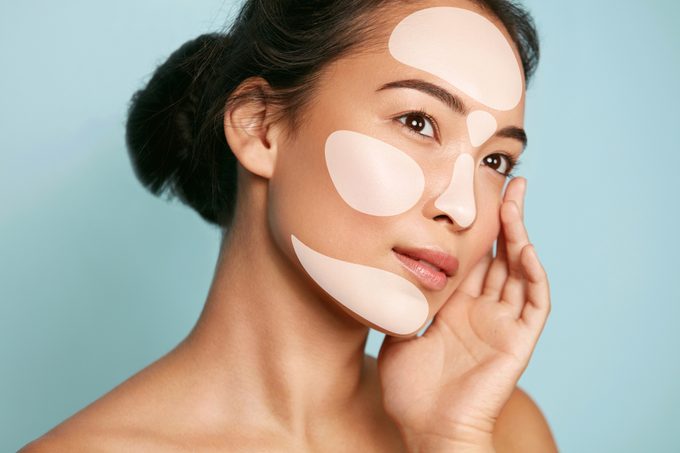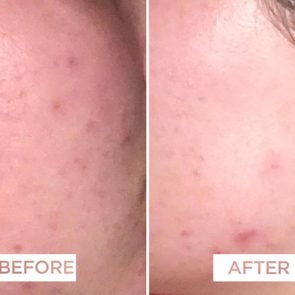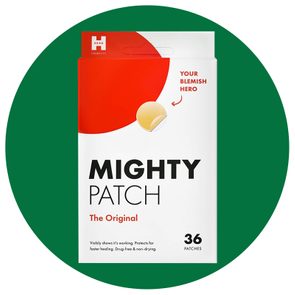What Is Acne Face Mapping—and Is It Accurate?
Updated: Mar. 30, 2022
Here's what a dermatologist thinks about the ancient technique of face mapping that promises to banish your blemishes.
Acne face map 101
If you’re acne-prone, you’re likely an expert at combing the internet for advice and quick cures for how to get rid of acne. One technique that comes up, again and again, is the acne face map.
An alternative medicine technique, acne face mapping links breakouts in specific zones of your face with underlying problems in other parts of your body. But before we explore this traditional Chinese system, let’s unpack what causes acne in the first place.
What is acne?
Acne is an inflammatory skin condition that includes a variety of different blemishes, says board-certified dermatologist Zain Husain, MD, a fellow of the American Academy of Dermatology and founder of the New Jersey Dermatology and Aesthetics Center.
Breakouts include:
-
Comedones (blackheads and whiteheads)
-
Papules (small red bumps)
-
Pustules (pus-filled bumps, such as pimples)
Acne occurs when there is an “overproduction of oil and buildup of bacteria” as a result of hormonal or pore-clogging factors, says Dr. Husain. Your face, neck, chest, back, and shoulders are most prone to acne because those areas contain the most functional oil glands, he says. (Here are the myths about what causes acne.)
What is an acne face map?
Acne face mapping is a diagnostic system that originated from ancient Chinese beliefs and Ayurvedic teachings. Proponents claim that poor inner health reflects on the outside; specifically, on your skin.
“Acne face mapping strips out the Chinese beliefs, focusing on more scientific causes of breakouts and long-term acne,” says Dr. Husain. “While there’s little research to prove that a specific factor can cause acne in a specific area, the technique is becoming more and more popular.”

How face mapping works
When you’re dehydrated, your skin gets dry. When you’re sick, your skin can take on a pale or sickly pallor. Acne face mapping takes this inner-outer connection even further by relating specific regions of your face to particular organs or health concerns. (Try these beauty tips to look good when you’re sick.)
As Dr. Husain points out, there’s scant scientific evidence that face mapping works to pinpoint unseen acne causes. And face maps also vary. Some face mapping practitioners divide the face into three or four zones, while others include nine or 10.
Acne face map: how to map your breakouts
Most acne face mapping sources agree on the following facial zones and acne triggers:
-
Chin and jawline acne. Acne face mapping links chin and jawline pimples to hormonal or reproductive health problems. According to a 2019 review of research by the Brazilian Society of Dermatology, adult female acne is most likely to occur along the jawline and chin, suggesting a link between this type of acne and monthly hormone fluctuations.
-
Acne between your eyebrows. Acne face maps link breakouts at the top of your nose and between your brows to liver dysfunction. In other words, perhaps you had too much to drink last night.
-
Nose acne. Acne on the nose relates to heart and lung health, indicating high cholesterol, blood pressure, or impending heart issues, according to proponents of face mapping.
-
Forehead acne. Acne face mapping suggests that your digestive system and liver influence forehead breakouts. Thus, poor nutrition or overindulging in certain foods or drinks could cause forehead breakouts.
-
Cheek acne. This is linked to stomach and respiratory issues such as poor digestion or allergies. Though outer acne triggers are not relevant in face mapping, it’s worth noting that touching your face with dirty hands, a dirty phone, or an unwashed pillowcase could add bacteria to your cheeks. (Here are some other reasons for skin problems like acne.)
(Facial reflexology follows a similar theory—learn more.)
A dermatologist’s take on face mapping
Acne face mapping has existed for centuries, but there still isn’t much evidence that it works.
“Acne mapping is not a common technique used by dermatologists,” says Dr. Husain. “The research is not robust, and there is a lack of controlled studies showing its accuracy.”
According to Dr. Husain, an acne face map is not a helpful way to pinpoint the cause of your breakouts. He recommends following science-backed methods or seeing a certified dermatologist, instead.
How to treat acne at home
Fortunately, an acne face map isn’t the only at-home technique for tackling your breakouts. Incorporating the right products into your daily skincare regimen can work wonders. (Here’s the pimple treatment dermatologists use.)
Dr. Husain recommends starting with a facial cleanser that contains benzoyl peroxide, salicylic acid, or glycolic acid. For spot treatment, he suggests products with niacinamide, azelaic acid, and adapalene. Next, use a daily moisturizer (yes, even if you have oily skin). Always opt for acne treatments that are also good for your skin type, too.
“It is vital to keep the skin hydrated,” says Dr. Husain. He suggests buying a noncomedogenic facial lotion that contains ceramides. Then complete your morning routine with a physical sunscreen to keep your skin protected. These are signs you bought the wrong kind of sunscreen.
When to see a dermatologist
If you’re experiencing cystic acne or your breakouts aren’t improving with the above skincare routine, Dr. Husain says it’s time to see a dermatologist. Rather than using a blanket technique like acne face mapping, a dermatologist will examine your face and discuss your medical history to pinpoint the medical cause of your breakouts. If you’re a female, you might also undergo hormone tests.
Your acne treatment will depend on the underlying cause of your acne. “Often, there are topical and oral treatments that can be helpful, including antibiotics, anti-androgenic medications, retinoids, and exfoliants,” says Dr. Husain. And “there are light treatments that can be helpful, as well as chemical peels.”



















